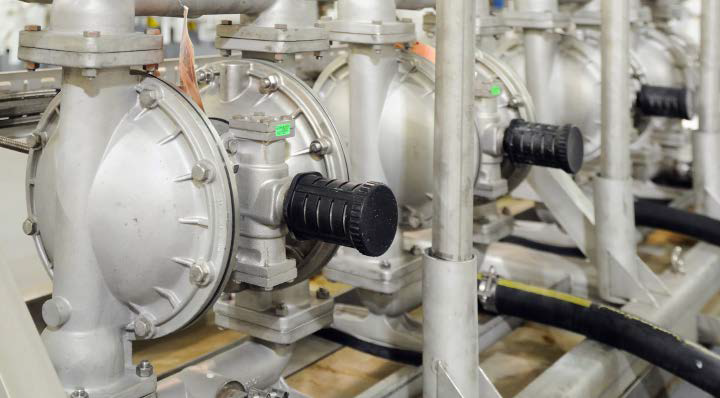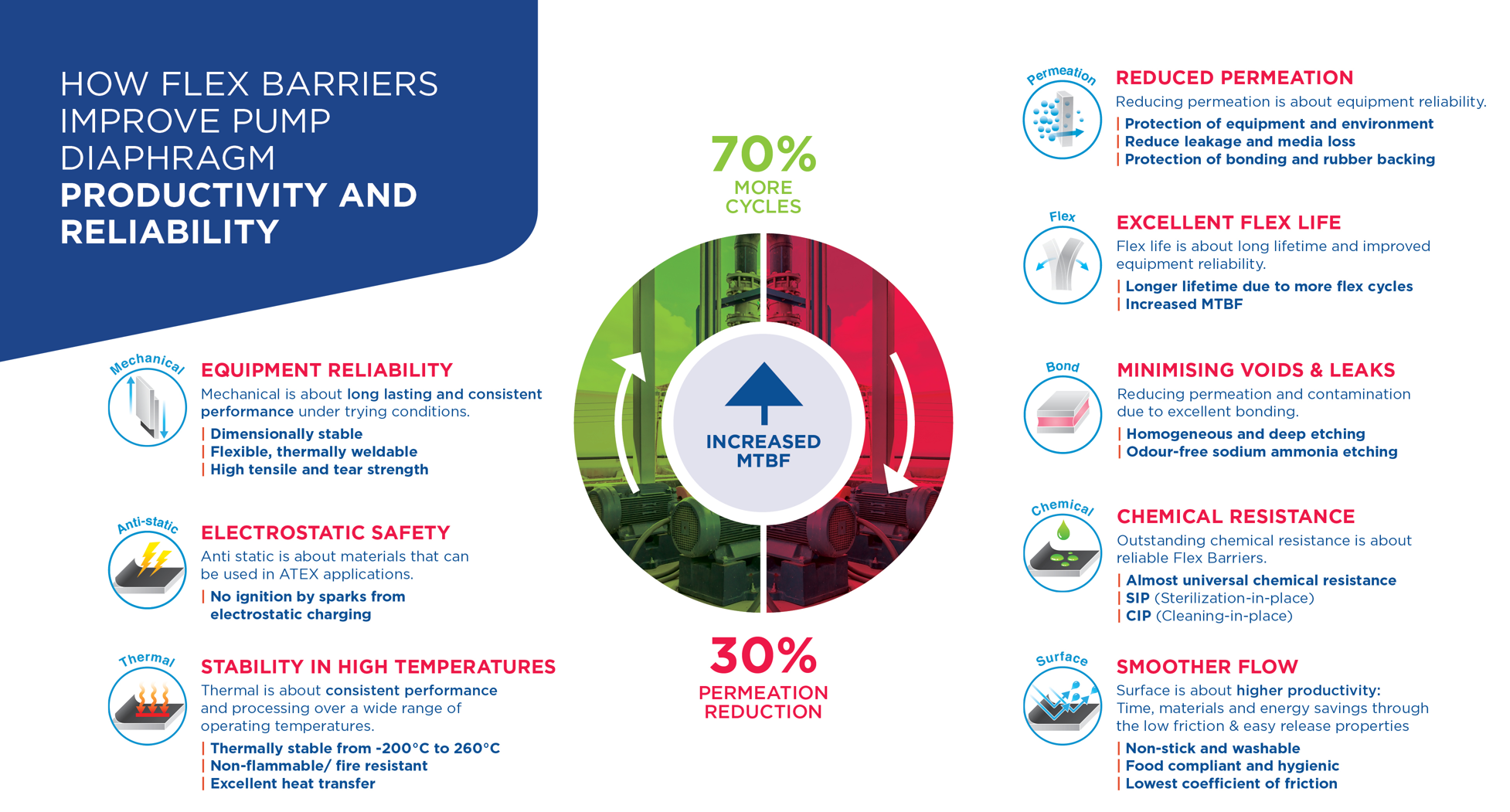Jul 16 2021
The use of pumps with diaphragms has grown substantially in recent years, as industries increasingly recognize the contribution that pumps make to process engineering.
This article explores the use of flexible barrier materials for diaphragms and its potential to solve challenges typically faced by an air-operated double diaphragm (AODD) and dosing/metering pumps.
While both utilize diaphragms, AODD and dosing/metering pumps are two distinct types of positive displacement pumps.
The AODD pump is typically utilized in the transfer of higher volume liquids, while the dosing/metering pump is employed in the continuous in-phase metering of single or multiple liquid systems operating at varying flow rates.
A key reason for the growing demand for hydraulically actuated and mechanically coupled diaphragm pump heads is the increasing availability of materials ideal for the development of diaphragms.
The use of the synthetic materials polytetrafluoroethylene (PTFE) and thermoplastic elastomers (TPE) in the manufacture of diaphragms has led to new possibilities for AODD and dosing/metering pumps.
Both pump types require that the diaphragm material is flexible at low temperatures, resistant to deterioration at high pressures and temperatures, and compatible with the fluid being pumped.
AODD Pump Diaphragms
AODD pump designs have evolved over the past 50 years into a proven technology able to accommodate complex fluid transfer needs across many industries. The pump’s reputation is founded on the technology’s capacity to work with a diverse array of liquids with varying characteristics.
The AODD pump is able to accommodate fluid that is thin, thick, particle-free or in the form of slurry. The design of the pump enables it to pull in the liquid and drive it downstream, regardless of the liquid’s composition.
The diaphragms in an AODD pump are extremely important - if they fail, then the pump fails. Compressed air acts upon the diaphragm causing the liquid media to be pulled into the pumping chamber and ejected without requiring any rotating parts.
The only dynamic components in contact with the fluid while the pump is running are two diaphragms connected by a common shaft, two inlet valve balls and two discharge valve balls. The diaphragms function as a separation membrane between the fluid and the compressed air supply.
Using compressed air to drive the diaphragms balances the load on the diaphragm, removing mechanical stress and therefore extending diaphragm life. The valve balls open and close on the valve seats in order to properly direct the flow.
The AODD pump is suitable for use at each stage of the liquid transfer production cycle, whether this is offloading raw ingredients from tankers or transporting processed or semi-processed product around a plant.
The pump can accommodate shear-sensitive fluids, ensure the continuous flow of thick and viscous fluids and provide a leak-free operation.

Diaphragm manufacturer Gottlob Dietz benefitted from using Saint-Gobain Flex Barriers, further increasing diaphragm reliability and lifetime for their global customers. Image Credit: Shutterstock

The Ariane Group encountered diaphragm rupturing problems with its Ariane 5 program, which were solved by Saint-Gobain’s Flex Barriers. Image Credit: Shutterstock
Correct Material Selection
In order to ensure safe pump operation, it is imperative that the correct material is selected for the diaphragm. A number of factors should be considered when selecting diaphragm materials. These include:
- Chemical compatibility
- Efficiency
- Cost
- Temperature range
- Flex-life
- Performance
- Abrasion resistance
- Sanitary standards
- Resistance to cleaning fluids
- Potential for particle build-up on the diaphragm surface
- Suction lift
The number of effective diaphragm materials has grown to meet this extensive range of operational criteria.
Diaphragms are regarded as the hardest working components in an AODD pump. They are often expected to work for up to 10,000 hours before requiring replacement.
Selecting an appropriate material to deliver this level of operating life is difficult because the desired flexibility of the diaphragms must be consistently maintained in order for the pump to function effectively on start-up.
When selecting a diaphragm, it is important to achieve maximum mean time between failures (MTBF). This requires specifically selecting diaphragm materials to cater for the fluid being pumped and the operating conditions of the pump.
It is preferable to utilize materials offering a long flex-life as these will ensure predictable performance, planned maintenance and infrequent membrane replacement.
AODD and dosing/metering pumps are often employed in harsh or outdoor environments, which require diaphragms to be able to withstand extreme temperatures.
Key Diaphragm Challenges
AODD and dosing/metering pumps are used in a range of different industries, with each industry posing its own unique set of challenges. Despite this, each industry shares common requirements that must be met.
Operators require pumps to act rapidly when called upon during the production cycle. Pumps must also ensure smooth, leak-free and accurate pumping, as well as low maintenance requirements.
Failure to meet these basic requirements will inevitably have a negative impact on production line efficiency. Any instance of pump downtime, product contamination, loss of product or component replacement will lead to increased running costs and a higher lifetime cost of ownership.
In some cases, these issues result in production delays, reduced capacity, dissatisfied or lost customers. It can also have a significant adverse impact on the company’s bottom line.
Industries such as pharmaceuticals, foodstuffs and personal care products pose challenges that are likely to be different from those in paints and coatings, wastewater and chemicals.
It is important that surfaces are compatible with relevant industry standards. They must also be ultra-smooth to ensure a smooth flow and crevice-free to mitigate the risk of solids becoming trapped. Surfaces must also be suitable for liquids used in clean-in-place procedures and not prone to cracking.
Break-up of the diaphragm surface can result in cross-contamination of the pumped media. This poses a particular risk where foodstuffs are being pumped. The media’s potential to shear, split or adhere to the diaphragm surface must also be considered.
Chemical processing applications typically involve the use of aggressive or hazardous media, and when pumped, this media often exhibits very low lubricity, which makes it abrasive.
These issues challenge the surface’s permeability, potentially leading to harmful vapors or volatile organic compounds leaking into the atmosphere or causing damage to pump components.
Diaphragm Solutions from Saint-Gobain Films & Fabrics
This extensive list of factors and risks can influence the performance of diaphragms and can prompt many industries into just accepting that there is no solution to this problem and that it must just be accepted. This is not the case, however.
Advances in the development and refinement of existing materials have enabled pump users to overcome the challenges outlined above, allowing them to ensure efficient production, enhance operational efficiencies and maintain vital bottom-line profit.
Saint-Gobain Films & Fabrics is an industry leader in the development of flexible barriers for diaphragms. These barriers have been shown to effectively challenge and solve a wide range of diaphragm-related issues, increasing flex cycles and diaphragm lifetime up to 70% more than regular, modified PTFE while reducing vapor permeability by 30%.
In developing our flexible barrier materials, Saint-Gobain Films & Fabrics have concentrated on the issues that impair diaphragm performance, the results being products that increase MTBF, improve productivity and extend pump working life through greater reliability.
Frank Sonnenschein, Head of European Business Development
Sonnenschein continued, “Compliance to all relevant international standards has been a priority in the development of Flex Barriers and developing the range of industries served. Our Flex Barriers have practically universal resistance to chemicals and highly aggressive media such as aromatic or chlorinated hydrocarbons, acids, caustics, ketones and acetates.”
Flex Barriers
The resins used in the manufacture of Saint-Gobain Films & Fabrics’ Flex Barriers conform to all key regulations essential to the success of sanitary, medical, pharmaceutical and food and beverage applications.
These include FDA21 CFR177.1550, (EC) No.1935/2004, (EU) No.10/2011, (EC) No.23/2006 (GMP), USP Class VI and 3-A Sanitary Standard.
The materials used also conform to REACH (EC) No.1907/2006 and RoHS (2011/65/EU) regulations, confirming that they do not include any banned or hazardous compounds prohibiting the materials being used in products.
Flex Barriers are developed on a foundation of high-quality raw materials. They are available in various constructions, for example, as single layer films or laminated composites.
Saint-Gobain Films & Fabrics employs specialized surface treatments alongside a proprietary process in order to ensure that its Flex Barriers offer low permeability, high flex life, high smoothness and a low coefficient of friction.
Customers have the option of thermoforming the resulting products to ensure the diaphragm is ideally sized for their application.
The special surface treatment allows the films to be designed for high-integrity bonding to the customer’s carrier diaphragm (generally made from rubber) before being thermoformed and vulcanized. This is usually performed in a single operation.
The PTFE barrier can also be pre-formed prior to vulcanization. Flex Barriers can be supplied to pump diaphragm manufacturers in rolls or as sheets that are ideal for standalone diaphragm components.

Image Credit: Saint-Gobain FILMS & FABRICS

Image Credit: Saint-Gobain FILMS & FABRICS
Problems Solved
PTFE rupture is one of the primary causes of premature diaphragm failure. Thankfully, this can be solved via the excellent flex life performance offered by Flex Barriers.
An often underappreciated benefit of these Flex Barriers is their gradual mode of failure as opposed to catastrophic, which means the sites have a chance to organize maintenance/replacement in a planned manner rather than having to deal with a sudden ‘line shutdown’ and material losses.
Frank Sonnenschein, Head of European Business Development
Flex Barriers also eliminate the diaphragm delamination that can result from low quality, inconsistent bonding of PTFE and rubber, or from damaging media permeation. This results in exceptional durability coupled with a considerably reduced stretch void index.
The potential for contamination due to a diaphragm’s rough surface is eliminated by the barrier’s smooth, inert surface.
Deep drawing manufacturing issues - caused by stiff and heterogeneous material – are also mitigated by the Flex Barriers’ high quality and flexibility.
Successful Applications
Flex Barriers from Saint-Gobain Films & Fabrics have proven to be extremely beneficial for the diaphragm manufacturer Gottlob Dietz.
Gottlob Dietz has been able to leverage the quality of Flex Barriers to further increase diaphragm reliability and lifetime for their global customers.
Gottlob Dietz began utilizing the new Flex Barriers in order to reduce the risk of failures from disc rupture and delamination between PTFE and rubber backing on pharmaceutical dosing pumps.
This increased lifetime and flexibility while exhibiting enhanced permeability resistance and improved bonding strength with the rubber backing.
The Ariane Group encountered issues with diaphragm rupturing during thermoforming, chemical resistance to rocket fuels and permeation during its Ariane 5 space program.
These problems affected the entire program not only due to costs but mainly to safety reasons. Working together, we solved these problems through the co-development of a multi-layer fluoropolymer laminate solution.
Frank Sonnenschein, Head of European Business Development
Ariane was able to use this product to resolve the safety issue, ensuring that the rocket was able to enter space with a more efficient fuelling system.
This cooperation has enabled Saint-Gobain Films & Fabrics to reach higher levels of formability than had previously been possible, and the improved mechanical robustness of these new materials creates the potential to substitute steel diaphragms, further reducing pump costs and size.
Acknowledgments
Produced from materials originally authored by Frank Sonnenschein from Saint-Gobain Films & Fabrics.

This information has been sourced, reviewed and adapted from materials provided by Saint-Gobain FILMS & FABRICS.
For more information on this source, please visit Saint-Gobain FILMS & FABRICS.